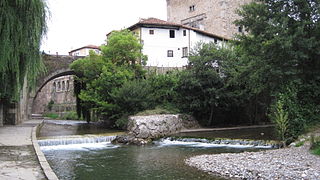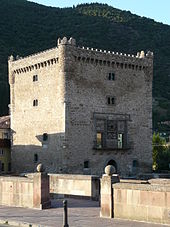Potes
| Potes | ||
|---|---|---|
 Potes - place view
|
||
| coat of arms | Map of Spain | |

|
|
|
| Basic data | ||
| Autonomous Community : | Cantabria | |
| Comarca : | Liébana | |
| Coordinates | 43 ° 9 ′ N , 4 ° 37 ′ W | |
| Height : | 291 msnm | |
| Area : | 7.64 km² | |
| Residents : | 1,343 (Jan 1, 2019) | |
| Population density : | 175.79 inhabitants / km² | |
| Postal code : | 39570 | |
| Municipality number ( INE ): | 39055 | |
| administration | ||
| Website : | Potes | |
Potes is a place and a municipality with 1,343 inhabitants (as of January 1, 2019) in the autonomous region of Cantabria in northern Spain . The small town is the capital of the Comarca Liébana and recognized as a cultural asset ( Bien de Interés Cultural ) in the Conjunto histórico-artístico category .
geography
location
Potes is located at almost 300 meters above sea level. d. M. at the intersection of four valleys and at the confluence of the Quiviesa river in the Río Deva , whose source is in the Picos de Europa . Potes is on the N-621 national road, which connects León to the Cantabrian coast via the San Glorio Pass, and on the CA-184, which leads to the province of Palencia via the Piedrasluengas Pass . The closest major city is Santander, approx. 104 kilometers (driving distance) to the northeast .
climate
Like the rest of the Liébana district, Potes has a Mediterranean microclimate, a. enables the cultivation of wine and other plants that are actually atypical for the mountainous location.
Population development
| year | 1960 | 1970 | 1981 | 1991 | 2001 | 2014 |
| Residents | 1,364 | 1,206 | 1,444 | 1,475 | 1,573 | 1,421 |
In the second half of the 19th century, Potes always had over 1,000 inhabitants.
Economy and Infrastructure
The soils and the rainy but mild climate were well suited for growing grain, wine and vegetables, although the inhabitants of earlier centuries lived largely as self-sufficient in this regard . Potes also functioned as a regional center for trade and handicrafts. Tourism has developed since the middle of the 20th century, which has been revitalized again with the creation of the Picos de Europa National Park in 1995.
history
An early settlement of the area is likely, even if the Celts , Romans, Visigoths and Moors left no traces on the municipal area. The place is mentioned for the first time in a document from the year 847 under the name Pautes ; it is the time of the beginning of the reconquest ( reconquista ) and resettlement ( repoblación ) by Christians from France and other parts of central Europe. A hundred years later, the existence of a church under the patronage of St. Vincent ( San Vicente ) is documented. In the late Middle Ages, Potes was the bone of contention between the noble houses of Manrique-Castañeda and Mendoza .
Attractions
The main attraction of the place is the historical center with:
- Torre del Infantado (today City Hall)
- Eremita de la Virgen de Valmayor
- Iglesia de San Vicente
- Eremita de la Virgen del Camino
- Torre de Orejon de la Lama
- Eremita de San Cayetano
- Torres de Calseco, San Pedro y de La Familia Osorio
- Convento de San Raimundo
Surroundings
- The Santo Toribio de Liébana monastery, only about three kilometers to the west, attracts many Spanish tourists every year.
- A trip to the pre-Romanesque church of Santa María de Lebeña , nine kilometers to the northeast, is also recommended.
- A well-known excursion destination is also the high valley Fuente Dé, about 23 kilometers to the west, with its cable car station.
gastronomy
The most famous dish from Potes is the chickpea stew Cocido Lebaniego . Other products from Potes are various types of cheese, honey and the orujo pomace brandy , which is distilled from the wine grown in the valley.
Web links
Individual evidence
- ↑ Cifras oficiales de población resultantes de la revisión del Padrón municipal a 1 de enero . Population statistics from the Instituto Nacional de Estadística (population update).


